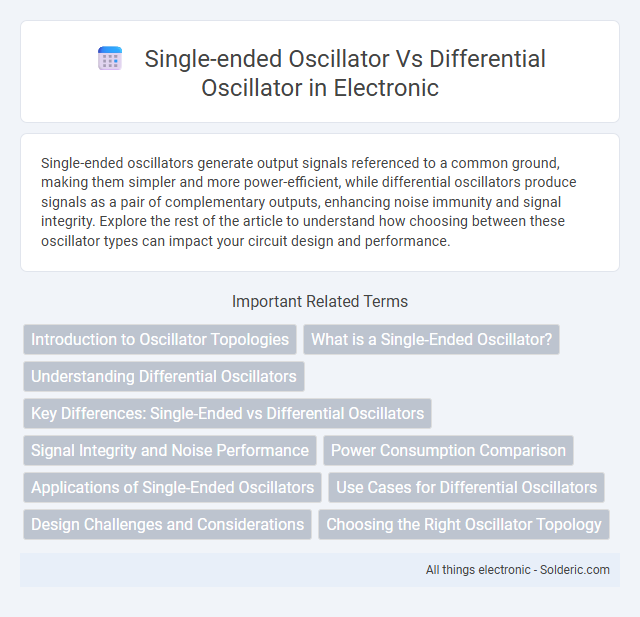Single-ended oscillators generate output signals referenced to a common ground, making them simpler and more power-efficient, while differential oscillators produce signals as a pair of complementary outputs, enhancing noise immunity and signal integrity. Explore the rest of the article to understand how choosing between these oscillator types can impact your circuit design and performance.
Comparison Table
| Feature | Single-Ended Oscillator | Differential Oscillator |
|---|---|---|
| Signal Type | Single output signal referenced to ground | Two complementary output signals |
| Noise Immunity | Lower noise immunity | Higher noise rejection and immunity |
| Power Consumption | Generally lower power consumption | Typically higher power consumption |
| Complexity | Simple design and implementation | More complex circuit topology |
| Output Swing | Limited voltage swing | Larger differential voltage swing |
| Common-Mode Rejection | Minimal common-mode signal rejection | Excellent common-mode rejection ratio (CMRR) |
| Application | Low-cost consumer electronics and basic timing | High-performance RF, communication, and precision timing |
Introduction to Oscillator Topologies
Single-ended oscillators utilize a single active device or transistor to generate periodic signals, making them simpler and more power-efficient but more susceptible to noise and distortion. Differential oscillators employ two complementary active devices in a balanced configuration, enhancing common-mode noise rejection and improving signal purity and stability. These topologies are crucial in RF and communication systems where trade-offs between complexity, power consumption, and signal integrity dictate oscillator selection.
What is a Single-Ended Oscillator?
A single-ended oscillator generates an oscillating signal using one active device and a single-ended output, making it simpler and more cost-effective than differential oscillators. It typically produces a waveform referenced to ground, making it ideal for applications requiring moderate frequency stability and low complexity. Your choice of a single-ended oscillator suits designs where minimizing component count and power consumption is critical.
Understanding Differential Oscillators
Differential oscillators use a pair of active devices configured to produce two complementary output signals, enhancing noise immunity and signal integrity compared to single-ended oscillators that generate a single output waveform. Their symmetry helps reduce harmonic distortion and common-mode noise, making them ideal for high-precision communication and clock generation applications. Understanding differential oscillators allows you to design circuits with improved stability, lower electromagnetic interference, and better performance in demanding analog and RF environments.
Key Differences: Single-Ended vs Differential Oscillators
Single-ended oscillators use a single signal path with a reference ground, producing an output harmonic with respect to ground, making them simpler but more susceptible to noise and distortion. Differential oscillators employ two complementary signal paths, generating output as the difference between these signals, which enhances noise immunity and reduces even-order harmonics for improved signal integrity. The choice between single-ended and differential oscillators depends on application requirements, including noise tolerance, signal purity, and complexity.
Signal Integrity and Noise Performance
Single-ended oscillators typically suffer from higher susceptibility to common-mode noise and electromagnetic interference, leading to reduced signal integrity compared to differential oscillators. Differential oscillators provide superior noise rejection by utilizing complementary signal paths that cancel out common-mode disturbances, resulting in enhanced signal purity and stability. This inherent noise immunity makes differential designs ideal for high-precision and low-noise applications where signal integrity is critical.
Power Consumption Comparison
Single-ended oscillators typically consume less power compared to differential oscillators due to their simpler circuit topology and fewer active components. Differential oscillators, with their complementary transistor pairs and balanced signal paths, often exhibit higher power consumption but offer improved noise immunity and signal integrity. Power efficiency in single-ended designs makes them suitable for low-power applications, whereas differential oscillators prioritize performance over energy savings.
Applications of Single-Ended Oscillators
Single-ended oscillators are commonly used in low-frequency applications such as clock generation in microcontrollers and signal modulation in communication systems due to their simple design and cost-effectiveness. These oscillators are ideal for integrated circuits requiring minimal power consumption and compact layouts, making them prevalent in consumer electronics and embedded systems. Their straightforward architecture allows easy integration with other analog components, enhancing their utility in sensor circuits and RF front-ends.
Use Cases for Differential Oscillators
Differential oscillators are preferred in high-performance communication systems and precision measurement devices due to their superior noise immunity and signal integrity. Your designs benefit from differential oscillators when minimizing common-mode noise and electromagnetic interference is critical, such as in RF transceivers and sensor interfaces. These oscillators excel in environments requiring balanced output signals and enhanced linearity compared to single-ended oscillators.
Design Challenges and Considerations
Single-ended oscillators face challenges such as susceptibility to noise and power supply variations, requiring careful layout and biasing to maintain frequency stability. Differential oscillators offer improved common-mode noise rejection and reduced even-order harmonics but demand precise device matching and increased circuit complexity. Design considerations include oscillator startup conditions, phase noise, and power consumption trade-offs tailored to the intended application environment.
Choosing the Right Oscillator Topology
When choosing the right oscillator topology, single-ended oscillators offer simplicity and easier implementation for low-frequency or low-power applications, while differential oscillators provide better noise immunity, higher output amplitude, and improved common-mode noise rejection ideal for high-frequency and precision applications. Your selection depends on factors such as signal integrity, power consumption, and the operating environment. Differential topology typically suits high-performance systems requiring greater stability and reduced electromagnetic interference.
single-ended oscillator vs differential oscillator Infographic

 solderic.com
solderic.com